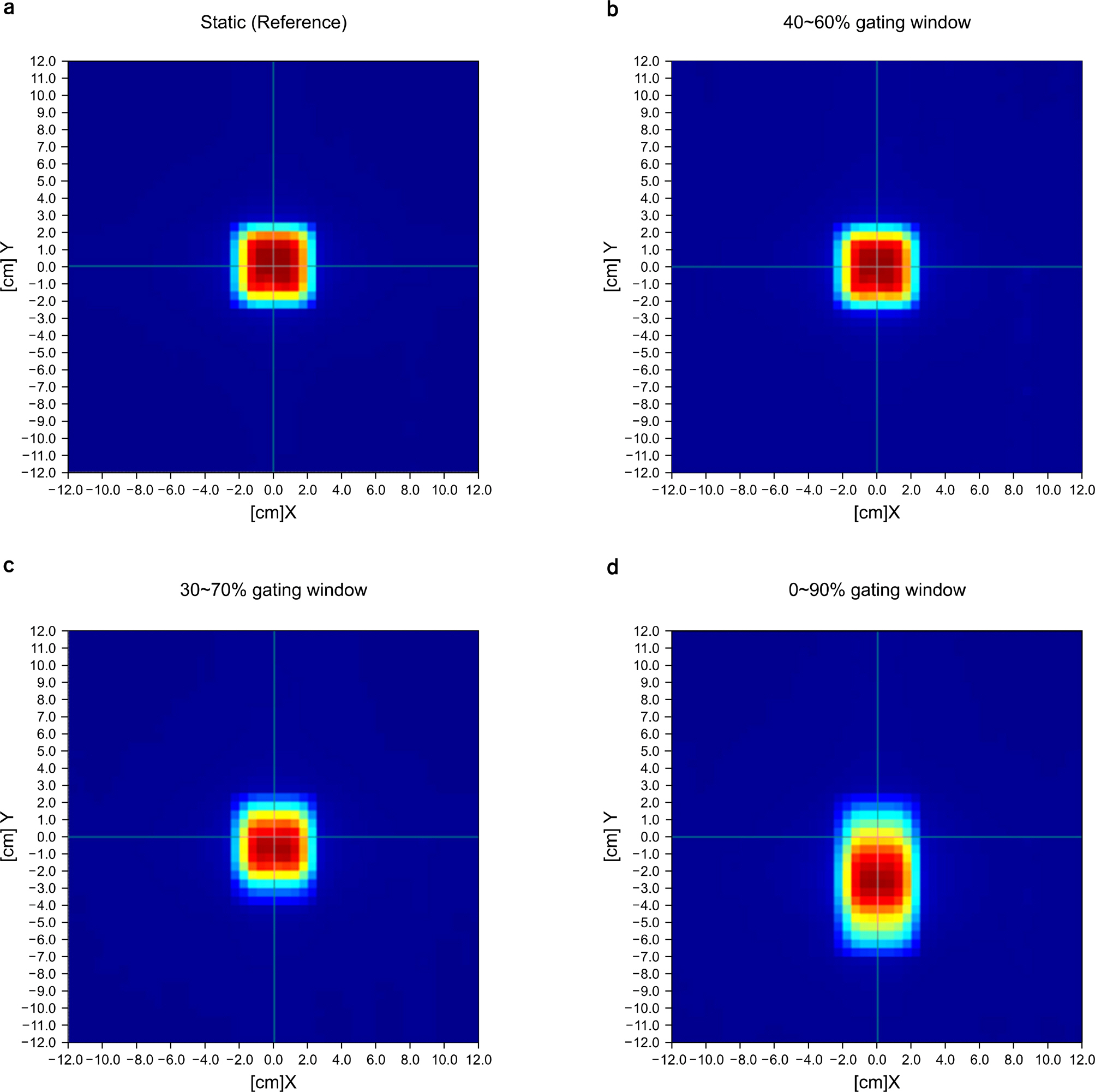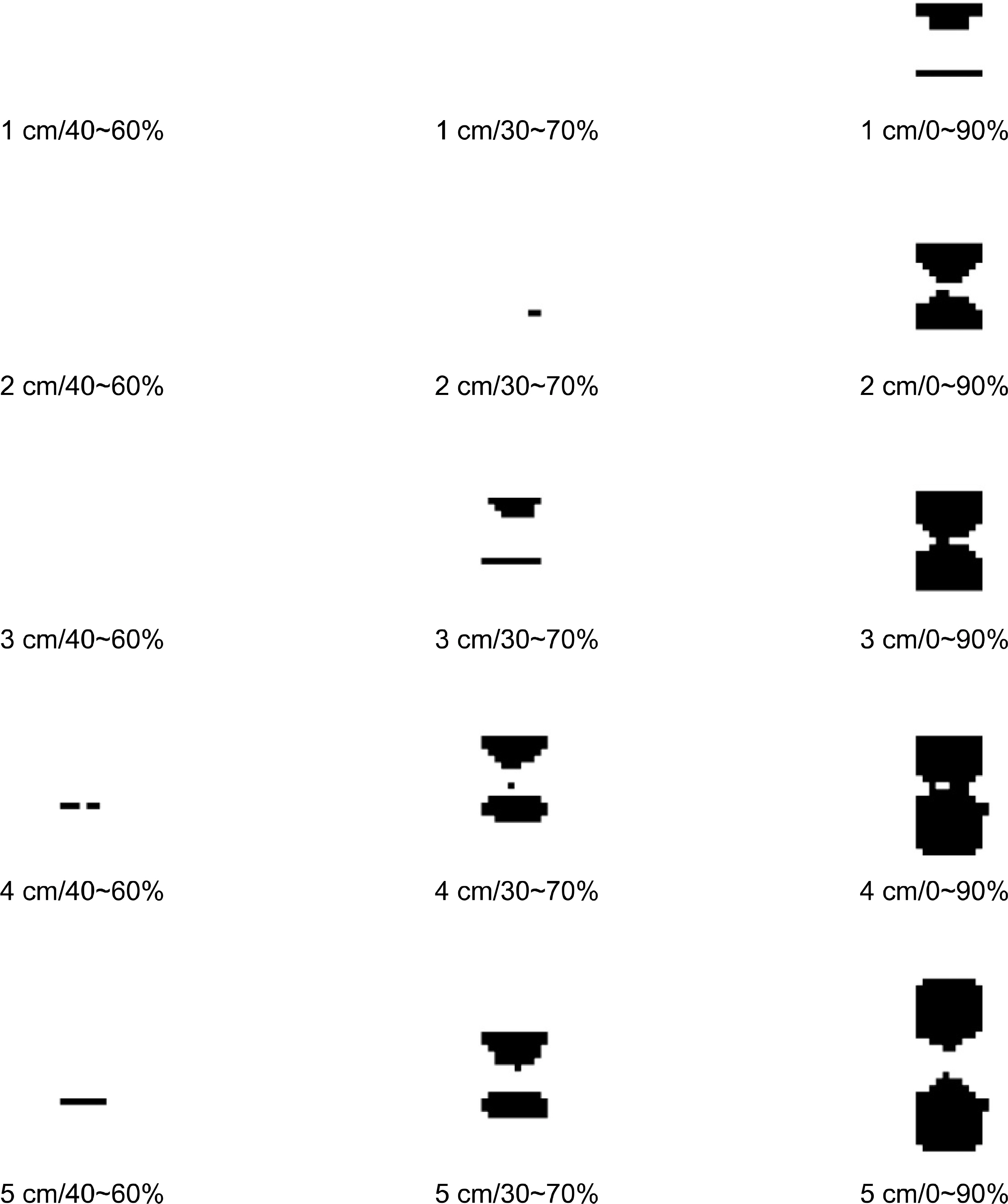Prog Med Phys.
2013 Sep;24(3):198-203. 10.14316/pmp.2013.24.3.198.
Quantitative Evaluation of Gated Radiation Therapy Using Gamma Index Analysis
- Affiliations
-
- 1Department of Radiation Oncology, Kosin University College of Medicine, Busan, Korea. medicalphysics@hotmail.com
- KMID: 1910585
- DOI: http://doi.org/10.14316/pmp.2013.24.3.198
Abstract
- Generally, to evaluate gated radiation therapy, moving phantoms are used to simulate organ motion. Since the target moves in every direction, we need to take into account motion in each direction. This study proposes methods to evaluate gated radiation therapy using gamma index analysis and to visualize adequate gating window sizes according to motion ranges. The moving phantom was fabricated to simulate motion in the craniocaudal direction. This phantom consisted of a moving platform, the I'm MatriXX, and solid water phantoms. A 6 MV photon filed with a field size of 4x4 cm2 was delivered to the phantom using the gating system, while the phantom moved in the 1-, 2-, 3-, 4-, and 5-cm motion ranges. The gating windows were set at 40~60%, 30~40%, and 0~90%, respectively. The I'm MatriXX acquired the dose distributions for each scenario and the dose distributions were compared with a 4x4 cm2 static filed. The tolerance of the gamma index was set at 3%/3 mm. The greater the gating window, the lower the pass rate, and the greater the motion range, the lower the pass rate in this study. In case treatment without gated radiation therapy for the target with motion of 2 cm, the pass rate was less than 96%. But it was greater than 99% when gated radiation therapy was used. However gated radiation therapy was used for the target with motion greater than 4 cm, the pass rate could not be greater than 97% when gating window was set as 30~70%. But when the gating window set as 40~60%, the pass rate was greater than 99%.
Figure
Cited by 1 articles
-
Discrepancies between Calculated and Delivered Dose Distributions of Respiratory Gated IMRT Fields according to the Target Motion Ranges for Lung and Liver Cancer Patients
Youngkuk Kim, Sangwook Lim, Ji Hoon Choi, Sun Young Ma, Tae Sig Jeung, Tae Ik Ro
Prog Med Phys. 2014;25(4):242-247. doi: 10.14316/pmp.2014.25.4.242.
Reference
-
1. Allen AM, Siracuse KM, Hayman JA. Evalution of the influence of breathing on the movement and modeling of lung tumors. Int J Radiat Oncol Biol Phys. 58(4):1251–1257. 2004.2. Lim S, Park S, Ahn S, et al. Guiding curve based on the normal breathing as monitored by thermocouple for regular breathing. Med Phys. 34(11):4514–4518. 2007.
Article3. Arugr T, Ltami J, Aruga M. Target volume definition for upper abdominal irradiation using CT scans obtained during inhale and exhale phases. Int J Radiat Oncol Biol Phys. 48(2):465–469. 2000.4. Gagné IM, Robinson DM. The impact of tumor motion upon CT image interrity and target delineation. Med Phys. 31(12):3378–3392. 2004.5. Suramo I, Päivänsalo M, Myllylä V. Craniocaudal movements of the liver, pancreas and kidneys in respiration. Acta Radio Diagn (Stockh). 25(2):129–131. 1984.
Article6. ICRU Report 62. Prescribing, Recording, and Reporting Photon Beam Therapy (Supplement to ICRU Report 50), International Commission on Radiation Units and Measurements, Bethesda. 1999.7. Kubo HD, Hil BC. Respiration gated radiotherapy treatment: a technical study. Phys Med Biol. 41(1):83–91. 1996.
Article8. Ramsey CR, Scaperoth D, Arwood D, Oliver AL. Clinical efficacy of respiratory gated conformal radiation therapy. Med Dos. 24(2):115–119. 1999.
Article9. 임상욱. 동적 병소추적 방사선치료를 위한 호흡연동시스템에 관한 연구. 경기도, 경기대학교 박사학위논문. 2008.10. 성지원, 윤명근, 정원규, 배선현, 신동오, 김동욱. RapidArc를 이 용한 호흡연동 회전세기조절방사선치료 할 때 전달선량의 정 확성 평가. 의학물리. 24(2):127–132. 2013.11. 임상욱, 안승도, 박성호 등. 열전쌍 마스크를 이용한 호흡모사 팬텀 연구. 대한방사선종양학회지. 23(4):217–222. 2005.12. Seppenwoodle Y, Shirato H, Kitamura K, et al. Precise and real-time measurement of 3D tumor motion in lung due to breathing and heartbeat measured during radiotherapy. Int J Radiat Oncol Biol Phys. 53(4):822–834. 2002.
- Full Text Links
- Actions
-
Cited
- CITED
-
- Close
- Share
- Similar articles
-
- Comparative Study Between Respiratory Gated Conventional 2-D Plan and 3-D Conformal Plan for Predicting Radiation Hepatitis
- Assessment of Ventricular Function Using Gated Blood Pool Scan and Gated Blood Pool SPECT
- Strategy of Respiratory Gated Radiation Therapy for Lung Cancer Patient in Stereotactic Radiosurgery : Phantom Study
- Evaluation of the Accuracy for Respiratory-gated RapidArc
- Discrepancies between Calculated and Delivered Dose Distributions of Respiratory Gated IMRT Fields according to the Target Motion Ranges for Lung and Liver Cancer Patients





